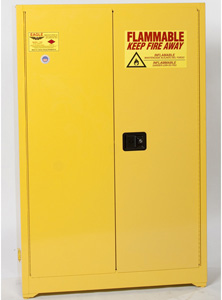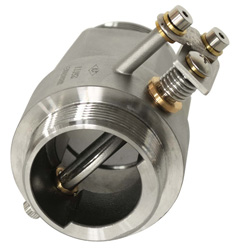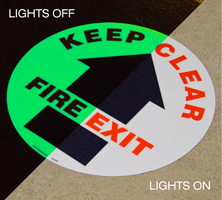



Find all of your laboratory and workplace safety supplies at Safety Emporium!
 Fibrosis |
 Glossary Index |
 Flammable aerosol |
| MSDS Topics |
Free Sites | FAQ's | Regulations | Glossary | Software | Suppliers |
| Books | Forum | Poll | Fun stuff | Quiz | Store | |
| Understand your MSDS with the MS-Demystifier | Search ALL our MSDS info | |||||

Store and dispense flammable liquids safely with flammable liquid safety cans from Safety Emporium.
A flammable material can be a solid, liquid or gas. The U.S. Occupational Safety and Health Administration (OSHA) defines a flammable liquid as "any liquid having a flash point at or below 199.4 °F (93 °C)."
Compare this definition to combustible, which indicates a material that is somewhat harder to ignite (flash point above 100 oF).
Note: The older term, inflammable is identical in meaning to flammable. To avoid confusion, only use the term flammable.
A material that is not flammable is called nonflammable.
Flammable solids and Flammable gases each have separate entries in this HyperGlossary.
For something to catch fire or explode, there has to be the right mix of heat, fuel and oxygen. These are defined by the flammable limits (also called the explosive limits) which are unique for each material.
OSHA Standard 29 CFR 1910.106, Flammable Liquids, has extensive information on the topic. The Standard divides flammable (and combustible) liquids into four classes:
| Category | Criteria |
| 1 | Flash point < 23°C (73.4°F) and initial boiling point ≤ 35°C (95°F) |
| 2 | Flash point < 23°C (73.4°F) and initial boiling point > 35°C (95°F) |
| 3 | Flash point ≥ 23°C (73.4°F) and ≤ 60°C (140°F) |
| 4 | Flash point > 60°C (140°F) and ≤ 93°C (199.4°F) |
The Standard covers the following items:

Store your solvents safely with flammable storage safety cabinets from Safety Emporium.
The Flammable Liquid Standard also covers the design, construction, and capacity of flammable storage cabinets. Paragraph 1910.106(d)(3)(ii)(a) requires "the bottom, top, door, and sides of cabinet shall be at least No. 18 gage sheet iron and double walled with 1-1/2 inch air space. Joints shall be riveted, welded or made tight by some equally effective means. The door shall be provided with a three-point lock, and the door sill shall be raised at least 2 inches above the bottom of the cabinet." The cabinets must pass specific testing requirements/approvals and be labeled in conspicuous lettering with the statement Flammable - Keep Fire Away. Not more than 60 gallons of Category 1, 2, or 3 flammable liquids, nor more than 120 gallons of Category 4 flammable liquids may be stored in a storage cabinet.
Cabinets built to these specifications meet NFPA Code 30 requirements. If self-closing (see next paragraph), they also meet NFPA 1 and the International Fire Code (IFC) requirements. The codes are designed to provide up to 10 minutes of protection. providing enough time for personnel to evacuate and/or for fire sprinklers to kick in. Justrite has a two page summary of design and testing that explains this in more detail. Cabinets built to European standards EN 14470-1 and EN 14727 utilize intumescent seals that swell when heated as well as insulation boards to achieve up to 30 to 90 minutes of fire resistance.
Flammable storage cabinets aren't effective if they are left open, so their doors should never be physically propped open with an object such as a chair or brick. Self-closing flammable storage cabinets have built-in door prop mechanisms that allow the user to prop the door open during use (similar to how a screen door automatic closer operates), but have a fusible link that will melt when exposed to fire, thereby closing the door before the contents can ignite. States which have adopted NFPA 1 or the IFC (such as California), require flammable storage cabinets to be self-closing. Justrite maintains a list of safety cabinet self-close vs manual by state jurisdictions; note that local codes may supercede these.
If your existing flammable storarge cabinets have a manually operated door, retrofit kits are available to convert them to self-closing. You may wish to check with your state/local code enforcement office as well as the manufacturer before installing a retrofit kit to ensure that your alteration of the cabinet will not affect the performance or warranty. When purchasing a new cabinet, the price difference between a manual and self-closing model is typically in the range of 10-15% of the total price and is definitely worth worth the added cost!
Flammable liquids should be stored in suitable containers. For flammable solvents or fuels that are routinely dispensed, a safety can with a flame arrestor and bonding/gronding capability is recommended. Dispensing liquids such as methanol from glass jugs can result in flame-jetting, a catastrophic event that essentially turns the bottle into a flame thrower.

Vent your flammable storage safety cabinets safely with Safe-T-Vent thermally-actuated dampers from Safety Emporium.
NFPA reports that "In 2007-2011, U.S. municipal fire departments responded to an estimated average of... 160,910 fires per year starting with ignition of a flammable or combustible liquid...The flammable or combustible liquid fires resulted in an estimated 454 civilian deaths, 3,910 civilian injuries, and $1.5 billion in direct property damage per year." Always consult the Safety Data Sheet when working with materials that are flammable or combustible.
Proper storage and use of flammable materials is absolutely critical in maintaining a safe work place. Never use flammable materials near sources of heat, flame, sparks or static discharge (direct sunlight, furnaces, pilot lights etc.) or in unventilated areas. Solvent vapors are heavier than air. These can pool in low-lying areas and travel significant distances to an ignition source. Never store flammable liquids such as gasoline in a basement or garage where vapors could be ignited by a pilot light or other source.
Flowing liquids can generate static electricity. When transferring liquids from one container to another, even plastic ones, be sure to follow proper bonding and grounding procedures. The Canadian Centre for Occupational Health and Safety maintains a fact sheet on how to How to Work Safely with - Static Electricity.
Also be careful when cutting or welding fuel storage tanks and pipes. A number of fatal accidents have occured when residual vapors were ignited by sparks or flames - see the CSB and OSHA links below for examples.

Fire safety includes fire signs, tags and labels from Safety Emporium.
See also: combustible, flash point, flammable gas, flammable solid, flammable limits.
Additional definitions from Google and OneLook.
Entry last updated: Thursday, October 6, 2022. This page is copyright 2000-2025 by ILPI. Unauthorized duplication or posting on other web sites is expressly prohibited. Send suggestions, comments, and new entry desires (include the URL if applicable) to us by email.
Disclaimer: The information contained herein is believed to be true and accurate, however ILPI makes no guarantees concerning the veracity of any statement. Use of any information on this page is at the reader's own risk. ILPI strongly encourages the reader to consult the appropriate local, state and federal agencies concerning the matters discussed herein.